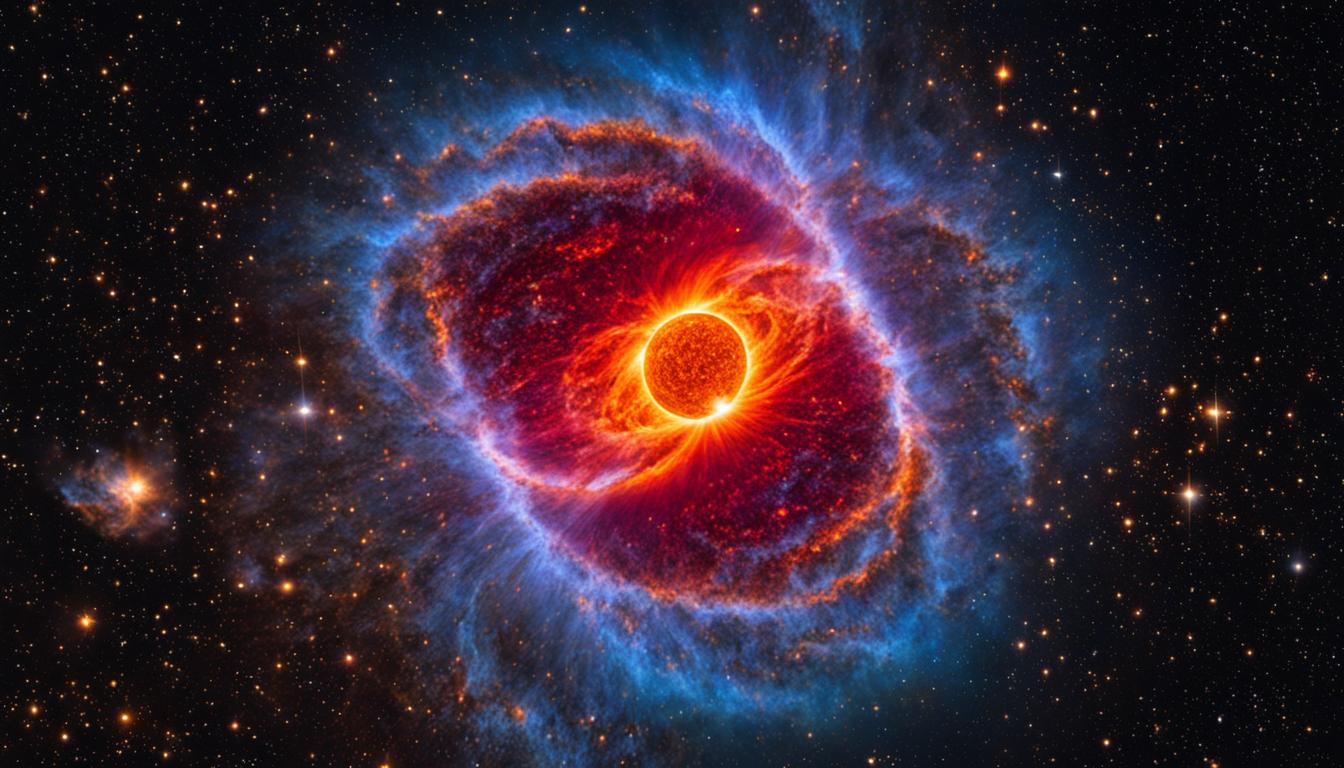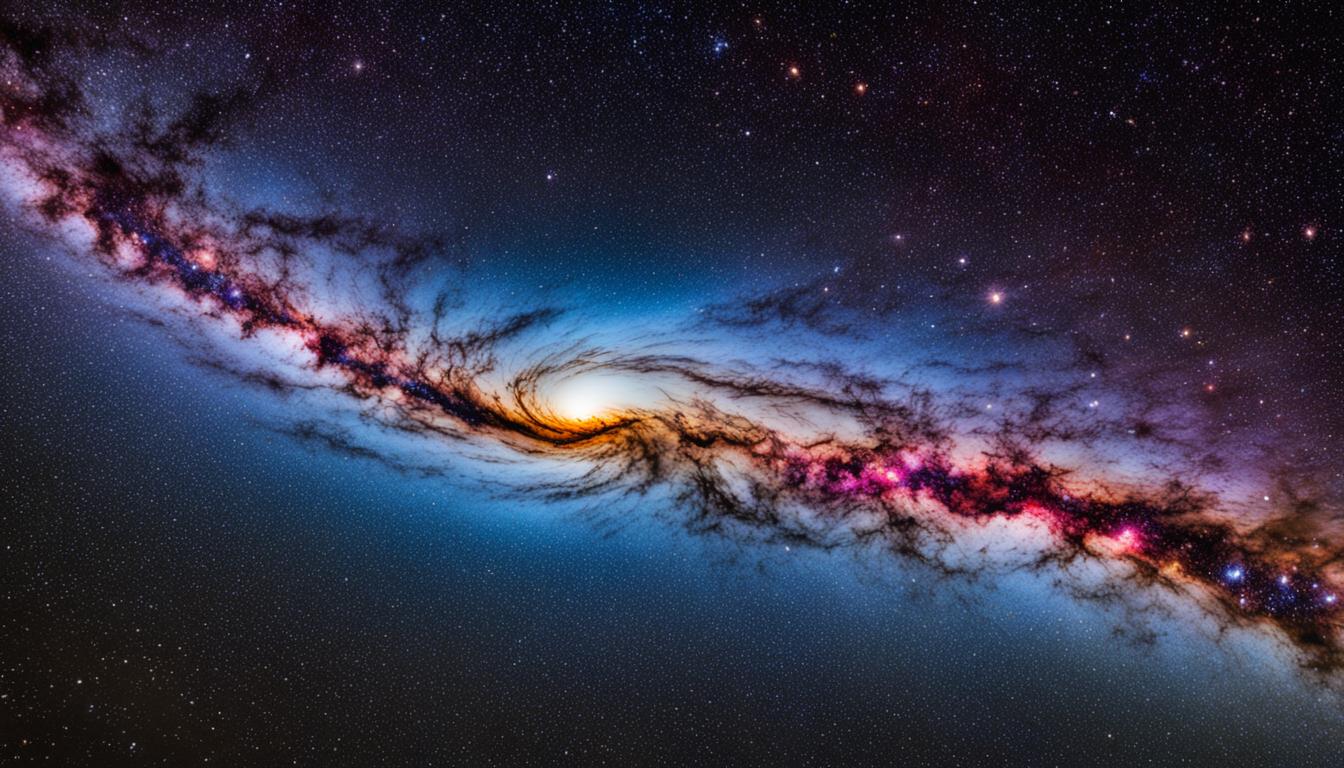Did you know UY Scuti is so huge it could hold over 5 billion suns? It’s seen as the biggest star in our Milky Way. This supergiant shows us just how vast stars can be.
When discussing heavenly bodies, UY Scuti represents the extreme size of the cosmos. It shows us how small we are in comparison. But UY Scuti is changing. It’s a red supergiant star that may explode soon. When it does, a neutron star or black hole may remain. UY Scuti’s size is not only interesting but also tells us about the life and end of large stars.
Because UY Scuti is the biggest star in the Milky Way Galaxy. However, how are we sure what is the biggest star in the Milky Way Galaxy? What are the other biggest stars in the Milky Way and how can be sure what is the biggest star in Milk Way Galaxy?

Introduction to Big Stars in the Milky Way Galaxy
Stars come in all sizes, from little dwarfs to huge giants. Our Milky Way Galaxy has some of the biggest stars in space. These stars, called giant stars or red supergiants, are truly massive. But their lives are short, and they end in stunning supernovae. Despite the stars ‘ short lives, these events make the universe even more beautiful.
The Milky Way has about 100 billion stars, covering a wide area. It’s a barred spiral galaxy, and our Sun is about 25,000 light-years from its center. A rotation around this center takes about 250 million years. Recent studies suggest the Galaxy has four spiral arms, a fact that scientists debate.
Our Galaxy also holds over 150 globular clusters, which are dense groups of stars. These can be very bright, even as bright as 25,000 Suns together. Open clusters, on the other hand, are much smaller. They have fewer stars and don’t shine as brightly. Yet, despite strong tidal forces, the open clusters near the Sun can last for over 200 million years.
Within our Galaxy, there are many collections of stars called stellar associations. They are usually about 250 light-years across. The stars within these groups come in all sizes, showing us the wide variety in the universe. This variety plays a big role in how our cosmos looks today.
Stars such as Antares and Betelgeuse are massive, being 832 and 887 times larger than the Sun. They stand out as symbols of the grandeur of our universe.
Criteria for Measuring Stellar Sizes
We focus on two key things when we talk about how big stars are.
- Radius.
- How brightly they shine.
Some stars are so big they make our Sun look like a tiny dot. Red supergiants, for example, can be thousands of times bigger than the Sun.
Take Mu Cephei or VV Cephei A, for instance. They are over 1,000 times larger than our Sun. And then there’s KY Cygni and V354 Cephei, showing us just how diverse star sizes can be.
Methods Used to Measure Stars
Measuring the size of these huge stars takes a mix of several methods. These include the Stefan–Boltzmann law and looking at the stars’ shadows when they pass in front of each other. These approaches help astronomers get more accurate measurements.
Even with precise methods, figuring out a star’s exact size can be challenging. Stars can change in size due to various reasons. RW Cephei, for example, poses difficulties with an estimated size of 1,530 times larger than the Sun.
Then, there are stars like WOH G64, with a size around 1,540 times the Sun’s. Plus, we have VY Canis Majoris, a giant in its own right. The key is to keep improving how we measure these massive stars. This way, we learn more about them in our Galaxy and beyond.
UY Scuti: The Current Biggest Star in Milky Way
UY Scuti is the largest star in our Galaxy, the Milky Way. It’s found about 5,900 light-years away in the Scutum constellation. This red supergiant star is huge, with a radius about 909 times that of our Sun. That’s roughly 632 million kilometers.
Despite its size, UY Scuti has a light mass between 7 and 10 times that of our Sun. It shines extremely bright, 124,000 times more than the Sun. Its brightness to us on Earth can vary between a magnitude of 8.29 and 10.56. We see it from so far away in the Milky Way, but its glow is still incredibly bright.

Characteristics of UY Scuti
UY Scuti is cooler than our Sun, with a temperature of around 3,550 K. But its massive size makes it over 100,000 times more luminous than our Sun. This size and brightness make it an important star, even though it’s cool.
Even with its big size, UY Scuti is losing mass at a rate of 5.8×10−5 M☉ each year. This loss creates a unique space around it. An interesting fact about UY Scuti is that it doesn’t have any known companion stars.
Lifecycle of UY Scuti
UY Scuti is in its later years as a red supergiant. Soon, it will go through a core-collapse supernova. The explosion from this event will end UY Scuti’s life. It might leave behind a neutron star or a black hole.
The end of UY Scuti’s life teaches us a lot about how stars like it evolve over time. This process is important in understanding the changes in our universe.
Biggest Stars in the Milky Way
The Milky Way Galaxy is full of incredible sights. It includes the largest and brightest stars ever seen. These stars are so big, they make our Sun look tiny. They help show us just how varied and vast the universe is.

VY Canis Majoris
VY Canis Majoris is a giant red hypergiant star. It’s in the Canis Major constellation. This star shines super bright and is very heavy. It is admired by astronomers for its size and light.
RW Cephei
RW Cephei is a supergiant star in the Cepheus constellation. It changes in brightness and is very large. Astronomers find this star’s behavior fascinating.
Mu Cephei
Mu Cephei is known as Herschel’s Garnet Star. It’s a beautiful red supergiant. It stands out because of its red color. This star is very big and looks amazing in the night sky.
WOH G64
WOH G64 is in the Large Magellanic Cloud. It’s a massive hypergiant star. Its size shows us how big stars can really get in our universe.
RSGC1-F01
RSGC1-F01 is another supergiant star. It’s very large and bright. It’s an important part of its star cluster. This star shows the amazing variety of supergiant stars in our Galaxy.
Challenges in Measuring the Biggest Star in Milky Way
Measuring the largest star in our Galaxy isn’t easy at all. It’s full of astronomical challenges. These involve huge distances and the changing atmospheres of supergiant stars. Because of this, finding the biggest star tests our scientific knowledge to its limit.
Uncertainties and Inconsistencies
Finding out exactly how big stars are is a big challenge. This is mainly because stars like UY Scuti can vary in brightness and temperature, giving us mixed results. Also, when these stars get bigger and smaller as they pulsate, measuring them becomes more complex.
Influence of Observation Methods
How we look at stars plays a big part in our understanding. Some methods, like watching stars hide behind the moon or each other, can tell us a lot. But we can’t use them all the time. Other ways, based on certain laws, give us general estimates but not exact sizes. Choosing how to observe affects how certain we are about a star’s size.
Scientists, such as Gwendolyn Eadie, have made big contributions using new methods. They look at the speeds and locations of star groups. Their work, combined with the Gaia mission and Spitzer Space Telescope, has advanced our knowledge. However, it also shows us the many challenges and limits we still have in astronomical studies.
Conclusion
The biggest star in the Milky Way Galaxy is UY Scuti by a big margin. There are also many other big stars in our Galaxy that are scattered all around. Since they are fairly close to us, to Earth, because they are in our Galaxy, it is easy to spot them. It’s also easy to accurately know how big or small a star is.
That’s why we are pretty certain that the big stars that we have are actually big, and the sizes are accurate. We see the Milky Way filled with over 150 clusters. These clusters glow up to 50 times brighter than 25,000 Suns. They are between 11 and 13 billion years old, telling us more about our Galaxy’s design.
Studying these massive stars helps answer big questions about our universe. Thus, each new detail about these big stars broadens our understanding. It motivates us to continue exploring Milky Way and the space beyond.
FAQ
What is the biggest star in the Milky Way Galaxy?
UY Scuti is the biggest star in our Galaxy. It’s over 1,700 times the size of the Sun. This makes it a giant red supergiant.
What are some examples of massive stars in the Milky Way?
The Milky Way has big stars like VY Canis Majoris, RW Cephei, and Mu Cephei. Each of these dwarfs the Sun by over a thousand times in size.
What defines the biggest star in the Galaxy?
Big stars are mainly known by how big they are. We measure their size compared to the Sun. Their brightness and measuring methods are also key.
What methods are used to measure the sizes of stars?
We use tricky ways to find out how big stars are. This includes the Stefan–Boltzmann law and watching stars pass in front of each other. These ways help us deal with stars’ changing brightness and size due to their pulsing.
What are the key characteristics of UY Scuti?
UY Scuti is very large, over 1,700 times bigger than the Sun. It’s ten times the Sun’s weight but shines 100,000 times brighter.
What is the lifecycle of UY Scuti?
UY Scuti is at its end stage and may explode in a supernova. It could leave a neutron star or black hole after it explodes.
What makes VY Canis Majoris notable?
VY Canis Majoris is a huge red hypergiant in our Galaxy. It’s among the largest stars, exceeding the Sun’s diameter by over a thousand times.
What is WOH G64?
WOH G64 is a large star in the Large Magellanic Cloud. It’s a good example of the very large stars that exist.
What challenges exist in measuring the biggest stars?
Measuring the size of the biggest stars is hard. The huge distances, stars changing size, and how we observe all cause problems. This can make it hard to know the exact size of these supergiant stars.